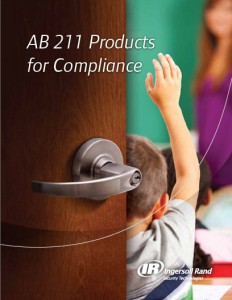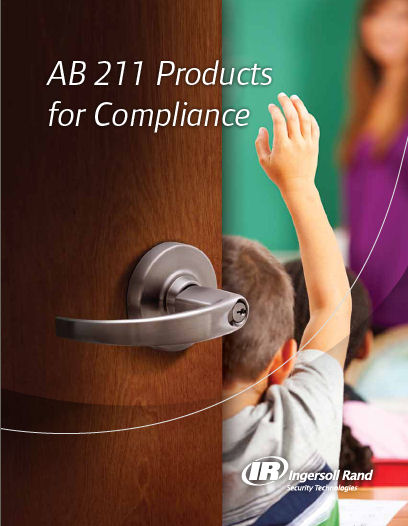 As of July 1st, 2011, a revised California law (AB 211, Article 8.5) requires classrooms and rooms with an occupant load of more than 5 people to be equipped with classroom security locks.* This pertains to all new construction projects submitted to the Division of the State Architect, which oversees K-12 schools and community colleges in the state of California.
As of July 1st, 2011, a revised California law (AB 211, Article 8.5) requires classrooms and rooms with an occupant load of more than 5 people to be equipped with classroom security locks.* This pertains to all new construction projects submitted to the Division of the State Architect, which oversees K-12 schools and community colleges in the state of California.
The bill was submitted by Assemblymember Tony Mendoza, who spent 10 years teaching in East Los Angeles, and had this to say about his motivation to introduce this bill:
“When I was teaching, we had a violent incident occur near campus during parent conferences,” said Assemblymember Mendoza. ”I taught in a portable classroom away from the main building of the school, and there was a shooting nearby. To lock and unlock the door of my classroom from the inside required an “L” wrench. Finding the tool and then fiddling with the lock in an emergency situation took too much time. This bill is critical to ensure teachers and staff can lock doors in a hurry for their protection and the protection of students. Today Californians can rest assured that we are in the process of making sure this safety concern will no longer be an issue.”
The increase in school violence over the last 15 years has prompted schools to evaluate their security and lockdown procedures, and a common problem is the use of traditional classroom function locksets on the classroom doors. To lock a classroom function lock, someone must open the door to access the key cylinder on the corridor side, which may expose them to the intruder. In the case of the Virginia Tech shootings, students had to barricade the door to keep the intruder out, who then shot through the closed door. Conversely, the lockdown procedure at Red Lake High School resulted in locked doors which thwarted the intruder’s attempts to access several classrooms.
While researching this article, I found several blogs and commentaries which illustrated that many people don’t understand how these locks work. Some think that the ability to lock doors from the inside would allow a perpetrator to lock himself in a room with his victim. Others think that these locks will impede egress. Classroom security locks do not impede egress – the door may be opened from the inside by simply turning the lever – even when the door is locked. The key cylinder on the inside is used to lock the outside lever only. Because a key is required to lock the door, it prevents students and others who don’t have access to the key from locking the door, placing this ability in the hands of the teacher or staff member.
The classroom security locks now mandated by California have been the standard for my specification department’s school specifications for many years. I am currently working with a local school system to upgrade their locks for accessibility, and we are addressing the classroom security issue at the same time. Although they may not be required by law in other jurisdictions, hardware consultants and others responsible for selecting hardware have an opportunity and a responsibility to educate school officials and improve the safety of our students and staff.
If you need assistance selecting classroom security locks or any door-related school security questions, feel free to contact me and I will put you in touch with a consultant in your area. There is no charge for these consultations.
*Note: In the years since this law was passed, there have been questions about whether the use of the term “classroom security lock” in the text of the law was intended to require what is commonly known in the door and hardware industry as a classroom security lock. Some schools prefer to use entrance/office function locks instead, which can be locked using an interior push-button or thumbturn instead of a key. It’s best to check with the local AHJ to make sure that the required type of lock is installed, but it appears that the primary intent of the law is for doors to be lockable from within the classroom.
Resources:
Simple Safety Solution – Classroom Locks – USA Today
California Division of the State Architect Bulletin 11-05
National School Safety Study – American Association of School Administrators
SECURITY VS. EXITING… The Key to Locking Devices in California Schools
‘U’ faculty considers classroom doors that lock from the inside – The Michigan Daily
High school district installing “Columbine Locks” – SF Examiner
Stop the Madness – How universities should be responding to school shootings – Brett A Sokolow
NCEF Door Locking Options in Schools
You need to login or register to bookmark/favorite this content.






No amount of trying to educate employees about using security classroom locksets has worked in two local school districts. In one, the district Architect insisted that we specify a mortise office function lockset because “the teachers would not be able to find their key in order to lock the door from the inside.” In another district, the maintenance department director insisted that we specify an entrance function with a thumbturn on the inside.
That’s terrible! It solves one problem, but creates another. Now anyone can lock the doors, even the bad guys. 🙁
Lori. Other than electronic, we have only two choices for locking the door from the inside: 1) A key and 2) a thumbturn or button. I know all the arguments for and against each, but I have never heard about any study to determine which is better. We all know that during a real incident, people are impaired and coordination becomes an issue which would seem to cause a problem with the interior key cylinder option. The thumbturn allows someone to lock folks out. Neither solve the reach through problem where a door or side lite is nearby.
Why has the industry not done such a study. Engage some behavioral science group at a university somewhere and publish their findings? I have heard these issues discussed a lot with no one pointing to a specific study (perhaps someone could link us to such a study??) Also, I’m big on training and exercise. I would think T &E would go far to improving the results. Thoughts??
Hi Jim –
I don’t know of a study like this either. I’ll bring it up with our multi-organization group.
– Lori
An inside lock cylinder means keeping track of a key/intruder key, and more mechanical parts that can fail compared to a push button assembly. Anyone can operate a push button. Yes you can get locked out easier, but there are always faculty and staff nearby. A teacher should ALWAYS keep their keys on their person. Think of the time it takes to operate a key versus pushing a button.
I agree Gary, but office function doesn’t work for every district. I usually explain how office, classroom security, and storeroom locks work, and let the district decide.
– Lori